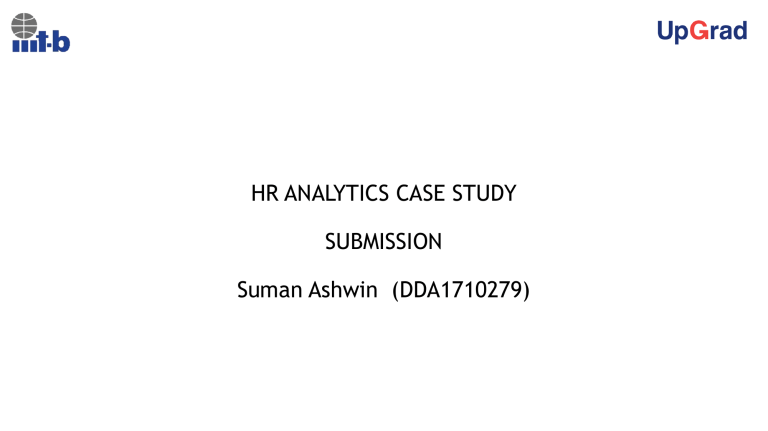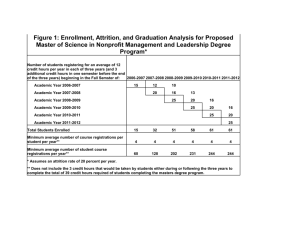
HR ANALYTICS CASE STUDY SUBMISSION Suman Ashwin (DDA1710279) HR Analytics Case Study Problem statement: A large company named XYZ, employs, at any given point of time, around 4000 employees. However, every year, around 15% of its employees leave the company and need to be replaced with the talent pool available in the job market. The management believes that this level of attrition (employees leaving, either on their own or because they got fired) is bad for the company: 1. The former employees’ projects get delayed, which makes it difficult to meet timelines, resulting in a reputation loss among consumers and partners 2. A sizeable department has to be maintained, for the purposes of recruiting new talent 3. More often than not, the new employees have to be trained for the job and/or given time to acclimatise themselves to the company Goal of the case study: ▪ To model the probability of attrition using a logistic regression. The results thus obtained will be used by the management to understand what changes they should make to their workplace, in order to get most of their employees to stay. Data available for the analysis There are 4410 observations and 41 variables after the Data preparation phase. The list of variables are as below. Problem Solving Methodology Approach for solving the case study We are breaking down our analysis in following ways: 1.Collate the given files after verifying EmployeeID is the primary key in all the datasets. 2. Since the In time and Out time Data contains the login/logout time stamps of the employees, we first treated this data and aggregated the number of working hours on a monthly basis for all the 12 months and also generated a derived metric called no_of_leaves. 3. We then did the second level of data cleaning on the entire dataset and stored it in a data frame named “employee1” 4. Performed the EDA(Univariate/Bivariate and correlation matrix) on the employee1 data frame to get insights about the data and did the feature engineering (derived metrics) relevant to problem domain 5. Performed the variable transformation(i.e. scaling continuous variables and creating dummy variables) 6. Arrived at the final model iterating through the logistic regression using the glm algorithm. 7. Performed the model evaluation on the test data and determined the optimal cut-off based on the predicted and actual test attrition rates. 8. In addition to the accuracy, specificity and sensitivity performance measures, also used the other performance measures and plots like the AUC,ROC,KS statistic. 9. Generated the lift and gain table and determined the position of the decile which contains the maximum KS statistic. Points to be noted… 1. For the NA imputation: For imputing the categorical variables: We replaced the NA's with the mode, i.e. the value that appears most time. In absence of any other information, #this provides the most likely answer We chose the median imputation for NA's in continuous variables. As median imputation will work better because it is a number that is already present in the data set and is less susceptible to outlier errors as compared to mean imputation. 2. In the process of variable transformation , we have converted the ordinal variables(for eg:, education level, job satisfaction level etc) to continuous variables for building the logistic regression model. Confirmed in the following research paper https://www3.nd.edu/~rwilliam/stats3/OrdinalIndependent.pdf 3. We performed the quantile method , but we could not detect any outliers, as there was no abnormal jumps in the values between the quantiles. Snapshot of the summary: Exploratory data analysis Findings: The plots reveal the proportion of attrition is high : 1. For those who travelled frequently 2. In HR department 3. Have educational background in HRM Exploratory data analysis cont. Findings: The plots reveal the proportion of attrition is high : 1. For job role as research director 2. For those with Marital status as single Exploratory data analysis cont. Findings: The plots reveal the proportion of attrition is high : 1. For education level 2 2. For job level 2 3. Stock option level 2 4. Environment satisfaction level 1 Where 1=low,2=Med,3=High,4=Very high Exploratory data analysis cont. Findings: The plots reveal the proportion of attrition is high : 1. For Job satisfaction level 1 2. For Work life balance level 1 3. Job involvement level 1 4. Performance rating 4 Where 1=low,2=Med,3=High,4=Very high Exploratory data analysis cont. Findings: The plots reveal: 1. Age: Majority of employees leaving the organization are aged around 30 years 2. Distance from home: Interestingly, employees who have left the company stay closer to office 3. Monthly income: Attrition is high in employees of lower income groups 4. Number of companies worked: Clearly people who have worked in one company before have higher attrition rate Exploratory data analysis cont. Findings: The plots reveal: 1.Percent Salary Hike: Employees with less than 15% hike have more chances to leave. 2. Total Working Years: larger proportions of employees with 1 year of experiences quitting the company also in bracket of 1-10 Years. 3.Traning Times Last Year: This indicates the no of trainings the employee has attended. People who have been trained 2-4 times is a problematic area Exploratory data analysis cont. Findings: The plots reveal: 1.Years at Company: Larger proportion of new comers are quitting the organization. Which sidelines the recruitment efforts of the organization. 2.Years Since Last Promotion: Larger proportion of people who have been promoted recently have quit the company. 3.Years With Current Manager: As expected a new Manager is a strong cause for quitting. Exploratory data analysis cont. Findings: The plots reveal: 1.Years at Company: Larger proportion of new comers are quitting the organization. Which side-lines the recruitment efforts of the organization. 2.Years Since Last Promotion: Larger proportion of people who have been promoted recently have quit the company. 3.Years With Current Manager: As expected a new Manager is a strong cause for quitting. 4. Contrary to the belief, the median number of leaves by proportion of people who have left the company is lower than people who have not left Exploratory data analysis cont. Findings:While the individual months doesn't give any insight, one thing that's evident is people who #left the company have a higher median working hours per month than those who have not Exploratory data analysis cont. Findings: The plots reveal: 1.Attrition is higher for the group of people whose tenureperjob is in the bracket of 0 to 10 2. Attrition is higher for years without change in bracket of 0 to 10 3. People with lower compa ratio have a high attrition rate indicating dissatisfaction towards the salary being drawn Correlation Analysis. Findings: The plots reveal: 1.Age is correlated to Total working years ( 68% correlation) 2. Total working years is correlated to years at company (61% correlation) 3. Yearsatcompany is correlated to yearssincelastpromotion (62% correlation) 4. Yearsatcompany is correlated to yearswithcurrentmanager (77% correlation) 5. Yearssincelastpromotion is correlated to yearswithcurrentmanager (51% correlation) Final logistic regression model:Explanation 1.We had 15 iterations for the modelling, and the final model is the 15th model. 2.There are total of 11 independent variables in our model and the coefficients, standard error, Z value and P values are tabulated below. 3.Negative coefficients indicates a negative correlation with the dependent variable and vice versa. - Signif. codes: 0 ‘***’ 0.001 ‘**’ 0.01 ‘*’ 0.05 ‘.’ 0.1 ‘ ’ 1 Final logistic regression model:Explanation cont. The deviance residuals ,Null deviance and residual deviance and AIC are as follows: Computing the statistical significance of the Null and Residual deviance using the chi square statistic: - This implies the deviance of the model only with constant term and deviance of the model with 11 independent variables added to it are the same, and we can reject the null hypothesis. Model Evaluation: Determining the optimal cutoff(on test data) Below is the performance measures( Accuracy, sensitivity and specificity for 3 cut off levels. Clearly , as the cut off decreases the sensitivity improves. The computed optimal cut off for our final model as calculated on the test data is 0.16 The plot on the right displays the accuracy, sensitivity and specificity based on the optimal cutoff value of 0.16. The colours of the different curves are denoted by the legends on the plot. - Model Evaluation: Few more performance measures 1. KS Statistics: KS Test measures to check whether model is able to separate events and non-events. KS = Maximum difference between Cumulative % Event and Cumulative % Non-Event. Ideally, it should be in first three deciles and score lies between 40 and 70.For our model , 0.43 is the Max k statistic for test data 2. Lift and Gain Table on test data: a)We can identify 75% of employees who are going to leave the company by contacting 40% of total employees. b) The Cum Lift of 3.71 for top decile, means that when selecting 10% of the records based on the model, one can expect 3.71 times the total number of targets (events) found by randomly selecting 10%of-file without a model. c) The maximum KS statistic is 46.53 and is in the second decile which is a very good indicator for the robustness of the model. - - Model Evaluation: Few more performance measures cont. 1. AUC (Area Under the curve) : Our model has an AUC of 0.72. AUC value of >0.70 is a an indication that the model is good. 2. ROC Curve: - Conclusions and Recommendations Based on the variables in the final model, we have the following interpretations and recommendations to the management: NumCompaniesWorked : Attrition is higher for a person who has worked in multiple companies. This could be an input to the hiring team to be wary of the people who have changed companies frequently. At least, they should interview that person in greater detail to find out if they had genuine reasons for changing. TotalWorkingYears - Lesser experienced people have a higher attrition rate possibly due to them not seeing growth opportunities. It's recommended to focus HR and management's energy on these individuals and show them a growth path in the organization. Giving access to senior staff who are willing to volunteer their time and energy to mentor the new entrants might help with this. - YearsSinceLastPromotion - Clearly, the longer an employee has- gone without a promotion, higher are the odds of them not staying in the company. For such employees, maybe a job rotation where their skills are better suited and chances of them growing are higher could be something HR can look into. Oct _hours: It could be that, employees are forced to put in long hours maybe even picking up slack for others especially during the last quarter. This leads to frustration followed by quitting. One feedback to HR and management is to introduce intermediate progress checking throughout the year rather than at the end. Conclusions and Recommendations cont. YearsWithCurrManager - When the manager changes, comfort level between employee and immediate supervisor is likely to get reduced. In many companies, it's very common for new managers to have a HR facilitated employee feedback session in the first six months of taking up the role. Such an exercise will help the employees point out any blind spots the manager can be having from the team's perspective and help improve the relationship with the manager and their team. EnvironmentSatisfaction/WorklifeBalance/Jobsatisfaction - If actionable items can be derived from the surveys, they should be published and management should be held accountable to take those actions and improve the satisfaction or employee perception. If employees don't see any changes inspite of giving feedback especially constructive feedback, they will move out. BusinessTravel.xTravel_Frequently - Put a cap on the travel or have mandatory breaks between travel, make provisions for virtual meetings, offer to rotate employee roles so they get a break from traveling - MaritalStatus.xSingle - This could be because such employees are not tied down to the locations, maybe have a little more time on their hands. Provide opportunities that involve business challenges, travel, contributing back to society, personal growth etc for such employees to retain them.



